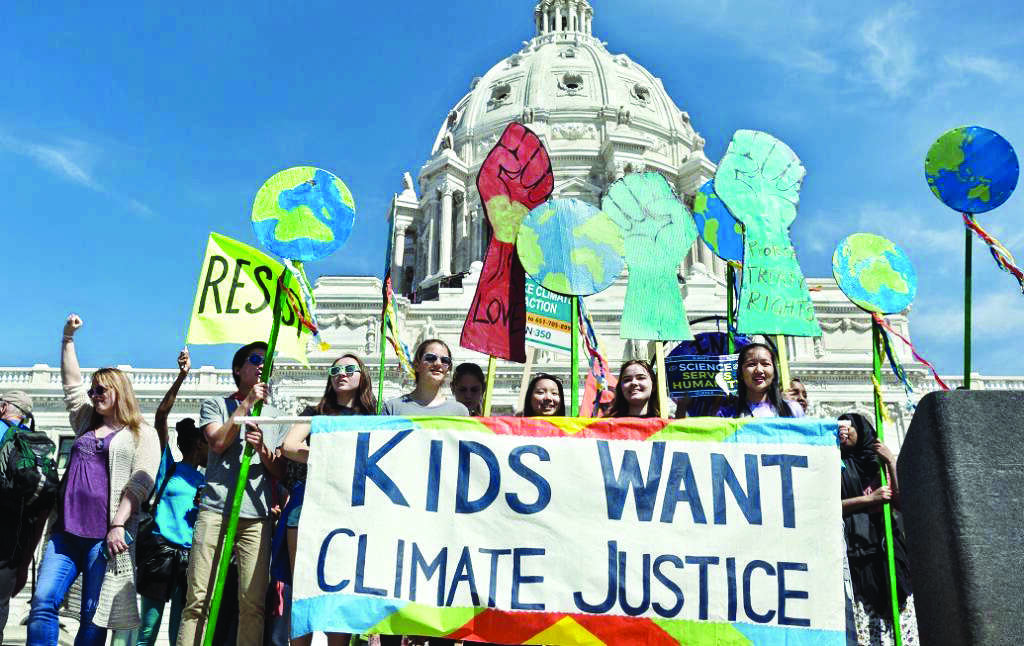Coming-of-age changemakers
Participation of children in design, planning and implementation of climate action can obliterate climate inequality; write Anindit Roy Chowdhury & Sohini Chakravorty

At the 2019 UN climate action summit, an angry teenager with a long plait walked into the stage and uttered, "We are at the beginning of a mass extinction and all you can talk about is money and fairy tales of eternal economic growth — how dare you"
Greta Thunberg was seen as the Trojan horse in the climate movement, drowned in the scepticism of climate deniers.
When asked why she was focusing on the climate crisis instead of leading the life of a typical teenager, she said young people are very concerned about the climate and ecological crises.
Unequivocal global warming, indiscriminate industrial practices, the use of fossil fuels and global policy paralysis have created an intergenerational child rights crisis.
Children and adolescents are at the core of the mitigation strategies and recovery process and can voice their unique needs as equal stakeholders. Solutions will not emerge keeping children on the fringes of climate discussions but by going back to the tenets of child rights.
A child born in 2020 will experience, on average, twice as many wildfires, 2.8 times the exposure to crop failure, 2.6 times as many drought events, 2.8 times as many river floods and 6.8 times more heatwaves across their lifetimes, compared to a person born in 1960.
Continued exposure to a harmful environment will have a catastrophic impact on children's mental and physical development.
Up to 132 million people will be pushed into extreme poverty due to climate change by 2030, estimated the World Bank.
The drivers of poverty in South Asia will primarily be food prices, health shocks and natural disasters with the worsening impact of cyclones, floods and other extreme climate events.
Repeated climate shocks directly or indirectly impact livelihood generation, food and water supply, accessibility to timely health services, learning continuity and force distress migration.
More than 4.5 crore people in India will be forced to migrate from their homes by 2050 due to climate disasters, stated Costs of climate inaction: displacement and distress migration report.
The most marginalised and vulnerable children are at the crossroads, deprived of essential services, losing their agency and resilience to fight future challenges.
In the last few years, the international development sector has witnessed a fundamental shift where past experiences and learnings can no longer define actions unless viewed from the lens of climate inequality.
Children are the custodians
of this planet and their inheritance is at stake.
They are the future changemakers, lawmakers and policyholders. If their participation isn't ensured in the design, planning and implementation of climate action, it violates their rights.
The Committee on the Rights, in its report, emphasises the access to environmental information and its risks. So that children can participate and express themselves in ecological and climate matters and make informed decisions, whether personal or for the development of the community.
Children's participation will increase their representation in environmental research and help identify policy risks and gaps.
Representation from disaster-prone regions will also help in designing and building resilient communities. Children can become facilitators of resilience among their peers, families and communities.
Gone are the days when children, particularly adolescents and young adults, could be kept in the margin as receivers of support.
Here are some recommendations to promote children's participation:
✵ Recognise the power of children's voices: Create an ecosystem for children to share and contribute, mobilise, campaign, advocate, demand and participate fully in discussions on climate change.
✵ Localise participatory planning process: Disaster and climate risk adaptive planning processes should involve communities at the Panchayat, Gram Sabha and urban local body levels. And these planning processes should have representation from children.
✵ Analysis of impact: Focused studies to document the impact of the climate crisis on children, particularly girls and other marginalised and deprived groups, to drive policy planning and implementation.
There's a popular saying that the best time to plant a tree was 20 years ago and the second-best time is now.
Children are critical stakeholders in addressing climate change concerns. We must empower them, work with them and facilitate their participation. Borrowing the words of 15-year-old Justina from Zambia, "If we can be the causers, we can be the solvers. Out Loud I Appeal"
Views expressed are personal



